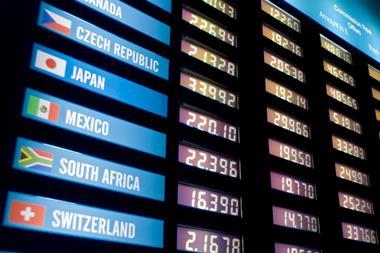Pension funds should see recent volatility in sterling and other currencies as a prompt to review their hedging positions, consultants have said.
A measure of weekly volatility of sterling showed expectations about the UK currency last week were at their most uncertain point since the country voted to leave the European Union.
The Japanese yen has been weakening versus sterling and the dollar in recent weeks, while the Chinese renminbi is also depreciating. The US dollar, meanwhile, strengthened in the weeks following the election of Donald Trump.
Given so much policy uncertainty, pension funds should make sure they are clear on their policies for currency exposure and hedging, said Dan Mikulskis, head of defined benefit pensions at Redington.
“One thing we are clear on is making sure clients are aware of all the risks,” he told IPE. “In fixed income it’s sensible to hedge currency risks as much as possible. In equity it’s a question of measuring the risks and making sure you’re happy with them.”
Trump’s victory in November’s US presidential election and the UK’s decision to leave the EU were both unpredicted, as were the reactions of financial markets, Mikulskis added.
“We don’t think there’s a lot of value in pension schemes trying to call idiosyncratic events like this,” he said. “Instead we would recommend a spread of risks – don’t have too much riding on individual events.”
Tim Giles, head of UK investment consulting at Aon Hewitt, said pension funds with unhedged exposure to global equities had seen “fantastic” performance in recent weeks.
“‘Should I lock in those gains?’ is the natural question,” he said.
Sterling’s recent weakness had led to it reaching a “reasonable” price, Giles added.
“It’s time to take a view about whether or not you want to take that risk,” he said. “We’re discussing this a lot with clients. You want to take the risks for which you expect to be rewarded. If you’re not happy with the potential gains then you shouldn’t be exposed to that risk.”
Andrien Meyers, senior investment consultant at JLT Employee Benefits, agreed, adding that most funds’ default position was to hedge 50% of their foreign exchange exposure to “soften” the impact of any movements.
The CIO of a large corporate UK pension fund said fully hedging out all currency exposure is “rarely optimal”, as having foreign currency allocations can have a risk-reducing effect on a portfolio.
The CIO, who asked not to be identified, also concurred with the importance of setting a policy on currency, and urged investors to ensure it applied to the entire portfolio.
“The currency doesn’t know what asset it is hedging,” he told IPE. “You’ve got to look at it holistically.”
Switzerland’s hedging lessons
In January 2015, pension funds in Switzerland were hit by the Swiss National Bank’s sudden decision to cut the franc’s peg to the euro. At the time, Willis Towers Watson estimated that as much as CHF30bn (€27.9bn) may have been wiped off pension portfolios.
However, pension funds such as AHV, BVK, and Publica all managed to mitigate much of the negative impact of the decision through currency hedging.
In the UK, sterling plummeted from €1.36 to the pound at the start of January 2016 to €1.23 the day after the UK voted to leave the European Union – a decline of 9.6%. In the same period, the UK currency fell 7.5% against the dollar.
By 16 January 2017, speculation about the direction and implications of the UK’s Brexit strategy had pushed the pound down to €1.14 and $1.20 – sterling’s lowest recorded level versus the dollar. The next day the currency rebounded slightly following a speech on the UK government’s plan for Brexit negotations by prime minister Theresa May.
As of 23 January sterling was trading at €1.16 and $1.25 – in both cases roughly 15% lower than at the start of 2016.









